Mapping the Rise in Machine Learning in Environmental Chemical Research: A Bibliometric Analysis
Abstract
1. Introduction
2. Methods
2.1. Dataset Collection
2.2. Dataset Analysis
3. Results and Discussion
3.1. Distribution by Year of Publication
3.2. Distribution by Affiliation and Country
3.3. Cooperation Network Relationship Analysis
3.4. Cited Sources Co-Citation Analysis
3.5. Cited References Co-Citation Analysis
3.6. Research Direction Analysis
3.7. Evolution of Research Directions
3.8. Translational Implications for Human Health Risk Assessment
3.9. Emerging Environmental Chemicals
3.10. Evolution of Keywords
4. Conclusions
Supplementary Materials
Author Contributions
Funding
Institutional Review Board Statement
Informed Consent Statement
Data Availability Statement
Conflicts of Interest
References
- Kleinstreuer, N.; Hartung, T. Artificial intelligence (AI)-it’s the end of the tox as we know it (and I feel fine). Arch. Toxicol. 2024, 98, 735–754. [Google Scholar] [CrossRef] [PubMed]
- Hartung, T. Artificial intelligence as the new frontier in chemical risk assessment. Front. Artif. Intell. 2023, 6, 1269932. [Google Scholar] [CrossRef]
- Piir, G.; Sild, S.; Maran, U. Interpretable machine learning for the identification of estrogen receptor agonists, antagonists, and binders. Chemosphere 2024, 347, 140671. [Google Scholar] [CrossRef]
- Zorn, K.M.; Foil, D.H.; Lane, T.R.; Russo, D.P.; Hillwalker, W.; Feifarek, D.J.; Jones, F.; Klaren, W.D.; Brinkman, A.M.; Ekins, S. Machine Learning Models for Estrogen Receptor Bioactivity and Endocrine Disruption Prediction. Environ. Sci. Technol. 2020, 54, 12202–12213. [Google Scholar] [CrossRef]
- Mansouri, K.; Abdelaziz, A.; Rybacka, A.; Roncaglioni, A.; Tropsha, A.; Varnek, A.; Zakharov, A.; Worth, A.; Richard, A.M.; Grulke, C.M.; et al. CERAPP: Collaborative Estrogen Receptor Activity Prediction Project. Environ. Health Perspect. 2016, 124, 1023–1033. [Google Scholar] [CrossRef]
- Ciallella, H.L.; Russo, D.P.; Aleksunes, L.M.; Grimm, F.A.; Zhu, H. Predictive modeling of estrogen receptor agonism, antagonism, and binding activities using machine- and deep-learning approaches. Lab. Investig. 2021, 101, 490–502. [Google Scholar] [CrossRef]
- Milosevic, N.; Milosevic, N.S.; Nedeljkovic, S.F.; Stanic, B.; Andric, N. Prediction of progesterone receptor binding potency, agonism and antagonism using machine learning models. Comput. Toxicol. 2025, 34, 100351. [Google Scholar] [CrossRef]
- Lane, T.R.; Vignaux, P.A.; Harris, J.S.; Snyder, S.H.; Urbina, F.; Ekins, S. Machine Learning and Large Language Models for Modeling Complex Toxicity Pathways and Predicting Steroidogenesis. Environ. Sci. Technol. 2025, 59, 13844–13856. [Google Scholar] [CrossRef]
- Sukur, N.; Milošević, N.; Pogrmic-Majkic, K.; Stanic, B.; Andric, N. Predicting chemicals’ toxicity pathway of female reproductive disorders using AOP7 and deep neural networks. Food Chem. Toxicol. 2023, 180, 114013. [Google Scholar] [CrossRef]
- Viganò, E.L.; Ballabio, D.; Roncaglioni, A. Artificial Intelligence and Machine Learning Methods to Evaluate Cardiotoxicity following the Adverse Outcome Pathway Frameworks. Toxics 2024, 12, 87. [Google Scholar] [CrossRef] [PubMed]
- Wei, H.; Sun, J.; Shan, W.; Xiao, W.; Wang, B.; Ma, X.; Hu, W.; Wang, X.; Xia, Y. Environmental chemical exposure dynamics and machine learning-based prediction of diabetes mellitus. Sci. Total Environ. 2022, 806, 150674. [Google Scholar] [CrossRef]
- Hu, X.C.; Dai, M.; Sun, J.M.; Sunderland, E.M. The Utility of Machine Learning Models for Predicting Chemical Contaminants in Drinking Water: Promise, Challenges, and Opportunities. Curr. Environ. Health Rep. 2023, 10, 45–60. [Google Scholar] [CrossRef]
- Sun, Y.; Wang, X.; Ren, N.; Liu, Y.; You, S. Improved Machine Learning Models by Data Processing for Predicting Life-Cycle Environmental Impacts of Chemicals. Environ. Sci. Technol. 2023, 57, 3434–3444. [Google Scholar] [CrossRef] [PubMed]
- Cojbasic, S.; Dmitrasinovic, S.; Kostic, M.; Turk Sekulic, M.; Radonic, J.; Dodig, A.; Stojkovic, M. Application of machine learning in river water quality management: A review. Water Sci. Technol. 2023, 88, 2297–2308. [Google Scholar] [CrossRef]
- Cui, S.; Gao, Y.; Huang, Y.; Shen, L.; Zhao, Q.; Pan, Y.; Zhuang, S. Advances and applications of machine learning and deep learning in environmental ecology and health. Environ. Pollut. 2023, 335, 122358. [Google Scholar] [CrossRef] [PubMed]
- Grisoni, F.; Consonni, V.; Ballabio, D. Machine Learning Consensus To Predict the Binding to the Androgen Receptor within the CoMPARA Project. J. Chem. Inf. Model. 2019, 59, 1839–1848. [Google Scholar] [CrossRef]
- Wan, H.; Xiang, L.; Cai, Y.; Xie, Y.; Xu, R. Temporal and spatial feature extraction using graph neural networks for multi-point water quality prediction in river network areas. Water Res. 2025, 281, 123561. [Google Scholar] [CrossRef] [PubMed]
- Valladares-Castellanos, M.; de Jesús Crespo, R.; Douthat, T. Using machine learning for long-term calibration and validation of water quality ecosystem service models in data-scarce regions. Sci. Total Environ. 2025, 1000, 180388. [Google Scholar] [CrossRef] [PubMed]
- Boroujerd, L.M.; Shakerdonyavi, A.; Asadgol, Z.; Donyavi, T.; Tavakoli, A.; Asl, Y.A.; Jabali, S.M.T.; Bahari, N.; Shahouri, M.; Safarpour, E. Machine learning-based prediction of drinking water quality index in Western Tehran using KAN, MLP, and traditional models. Environ. Monit. Assess. 2025, 197, 1065. [Google Scholar] [CrossRef]
- Chen, Y.; Wu, Y.; Zhang, S.; Yuan, K.; Huang, J.; Shi, D.; Hu, S. Regional PM2.5 prediction with hybrid directed graph neural networks and Spatio-temporal fusion of meteorological factors. Environ. Pollut. 2025, 366, 125404. [Google Scholar] [CrossRef]
- Li, T.; Huang, X.; Zhang, Q.; Wang, X.; Wang, X.; Zhu, A.; Wei, Z.; Wang, X.; Wang, H.; Chen, J.; et al. Machine learning-guided integration of fixed and mobile sensors for high resolution urban PM2.5 mapping. npj Clim. Atmos. Sci. 2025, 8, 95. [Google Scholar] [CrossRef]
- Zhang, Q.; Wang, Y.; Xiao, Q.; Geng, G.; Davis, S.J.; Liu, X.; Yang, J.; Liu, J.; Huang, W.; He, C.; et al. Long-range PM2.5 pollution and health impacts from the 2023 Canadian wildfires. Nature 2025, 645, 672–678. [Google Scholar] [CrossRef]
- Hou, D.; Jia, X.; Wang, L.; McGrath, S.P.; Zhu, Y.G.; Hu, Q.; Zhao, F.J.; Bank, M.S.; O’Connor, D.; Nriagu, J. Global soil pollution by toxic metals threatens agriculture and human health. Science 2025, 388, 316–321. [Google Scholar] [CrossRef]
- Ma, X.; Guan, D.X.; Zhang, C.; Yu, T.; Li, C.; Wu, Z.; Li, B.; Geng, W.; Wu, T.; Yang, Z. Improved mapping of heavy metals in agricultural soils using machine learning augmented with spatial regionalization indices. J. Hazard. Mater. 2024, 478, 135407. [Google Scholar] [CrossRef]
- Yarmohammadi, F.; Hayes, A.W.; Karimi, G. Research trends of computational toxicology: A bibliometric analysis. Toxicol. Res. 2024, 13, tfae147. [Google Scholar] [CrossRef]
- Jeong, J.; Choi, J. Artificial Intelligence-Based Toxicity Prediction of Environmental Chemicals: Future Directions for Chemical Management Applications. Environ. Sci. Technol. 2022, 56, 7532–7543. [Google Scholar] [CrossRef]
- Ajisafe, O.M.; Adekunle, Y.A.; Egbon, E.; Ogbonna, C.E.; Olawade, D.B. The role of machine learning in predictive toxicology: A review of current trends and future perspectives. Life Sci. 2025, 378, 123821. [Google Scholar] [CrossRef] [PubMed]
- Breiman, L. Random Forests. Mach. Learn. 2001, 45, 5–32. [Google Scholar] [CrossRef]
- Cortes, C.; Vapnik, V. Support-vector networks. Mach. Learn. 1995, 20, 273–297. [Google Scholar] [CrossRef]
- Lundberg, S.M.; Erion, G.; Chen, H.; DeGrave, A.; Prutkin, J.M.; Nair, B.; Katz, R.; Himmelfarb, J.; Bansal, N.; Lee, S.I. From Local Explanations to Global Understanding with Explainable AI for Trees. Nat. Mach. Intell. 2020, 2, 56–67. [Google Scholar] [CrossRef]
- Rogers, D.; Hahn, M. Extended-connectivity fingerprints. J. Chem. Inf. Model. 2010, 50, 742–754. [Google Scholar] [CrossRef]
- Yap, C.W. PaDEL-descriptor: An open source software to calculate molecular descriptors and fingerprints. J. Comput. Chem. 2011, 32, 1466–1474. [Google Scholar] [CrossRef]
- Jo, Y.; Shin, M.Y.; Kim, S. Assessing the association of multi-environmental chemical exposures on metabolic syndrome: A machine learning approach. Environ. Int. 2025, 199, 109481. [Google Scholar] [CrossRef]
- Hua, Y.; Shi, Y.; Cui, X.; Li, X. In silico prediction of chemical-induced hematotoxicity with machine learning and deep learning methods. Mol. Divers. 2021, 25, 1585–1596. [Google Scholar] [CrossRef]
- Pant, P.; Rajawat, A.S.; Goyal, S.B.; Chakrabarti, P.; Bedi, P.; Salau, A.O. Machine learning-based approach to predict ice meltdown in glaciers due to climate change and solutions. Environ. Sci. Pollut. Res. Int. 2023, 30, 125176–125187. [Google Scholar] [CrossRef]
- Liu, Z.; Dong, M.; Xue, W.; Ni, X.; Qi, Z.; Shao, J.; Guo, Y.; Ma, M.; Zhang, Q.; Wang, J. Interaction Patterns between Climate Action and Air Cleaning in China: A Two-Way Evaluation Based on an Ensemble Learning Approach. Environ. Sci. Technol. 2022, 56, 9291–9301. [Google Scholar] [CrossRef]
- Karak, P.; Parveen, A.; Modak, A.; Adhikari, A.; Chakrabortty, S. Microplastic Pollution: A Global Environmental Crisis Impacting Marine Life, Human Health, and Potential Innovative Sustainable Solutions. Int. J. Environ. Res. Public Health 2025, 22, 889. [Google Scholar] [CrossRef]
- Kida, M.; Pochwat, K.; Ziembowicz, S. Assessment of machine learning-based methods predictive suitability for migration pollutants from microplastics degradation. J. Hazard. Mater. 2024, 461, 132565. [Google Scholar] [CrossRef]
- Zheng, Y.; Zhou, H.; Peng, Y.; Wang, X.; Yang, Y.; Deng, Y.; Liu, Y.; Pan, H.; Zhao, X.; Yang, X.; et al. Deep learning-enhanced hyperspectral imaging for rapid screening of Co-metabolic microplastic-degrading bacteria in environmental samples. J. Hazard. Mater. 2025, 493, 138370. [Google Scholar] [CrossRef]
- Agyeman, P.C.; Ahado, S.K.; Borůvka, L.; Biney, J.K.M.; Sarkodie, V.Y.O.; Kebonye, N.M.; Kingsley, J. Trend analysis of global usage of digital soil mapping models in the prediction of potentially toxic elements in soil/sediments: A bibliometric review. Environ. Geochem. Health 2021, 43, 1715–1739. [Google Scholar] [CrossRef]
- Auzzas, A.; Capra, G.F.; Jani, A.D.; Ganga, A. An improved digital soil mapping approach to predict total N by combining machine learning algorithms and open environmental data. Model. Earth Syst. Environ. 2024, 10, 6519–6538. [Google Scholar] [CrossRef]
- Dvornikov, Y.; Slukovskaya, M.; Gurinov, A.; Vasenev, V. Soil type and content of macro-elements determine hotspots of Cu and Ni accumulation in soils of subarctic industrial barren: Inference from a cascade machine learning. Environ. Pollut. 2025, 377, 126457. [Google Scholar] [CrossRef]
- Limbu, S.; Glasgow, E.; Block, T.; Dakshanamurthy, S. A Machine-Learning-Driven Pathophysiology-Based New Approach Method for the Dose-Dependent Assessment of Hazardous Chemical Mixtures and Experimental Validations. Toxics 2024, 12, 481. [Google Scholar] [CrossRef]
- Long, T.Z.; Shi, S.H.; Liu, S.; Lu, A.P.; Liu, Z.Q.; Li, M.; Hou, T.J.; Cao, D.S. Structural Analysis and Prediction of Hematotoxicity Using Deep Learning Approaches. J. Chem. Inf. Model. 2023, 63, 111–125. [Google Scholar] [CrossRef]
- Maeda, K.; Hirano, M.; Hayashi, T.; Iida, M.; Kurata, H.; Ishibashi, H. Elucidating Key Characteristics of PFAS Binding to Human Peroxisome Proliferator-Activated Receptor Alpha: An Explainable Machine Learning Approach. Environ. Sci. Technol. 2024, 58, 488–497. [Google Scholar] [CrossRef]
- Nguyen, D.V.; Park, J.; Lee, H.; Han, T.; Wu, D. Assessing industrial wastewater effluent toxicity using boosting algorithms in machine learning: A case study on ecotoxicity prediction and control strategy development. Environ. Pollut. 2024, 341, 123017. [Google Scholar] [CrossRef] [PubMed]
- Zhao, P.; Peng, Y.; Xu, X.; Wang, Z.; Wu, Z.; Li, W.; Tang, Y.; Liu, G. In silico prediction of mitochondrial toxicity of chemicals using machine learning methods. J. Appl. Toxicol. 2021, 41, 1518–1526. [Google Scholar] [CrossRef]
- Zang, Q.; Rotroff, D.M.; Judson, R.S. Binary classification of a large collection of environmental chemicals from estrogen receptor assays by quantitative structure-activity relationship and machine learning methods. J. Chem. Inf. Model. 2013, 53, 3244–3261. [Google Scholar] [CrossRef]
- Ahmad, F.; Javed, K.; Tahir, A.; Khan, M.U.G.; Abbas, M.; Rabbani, M.; Shabbir, M.Z. Identifying key soil characteristics for Francisella tularensis classification with optimized Machine learning models. Sci. Rep. 2024, 14, 1743. [Google Scholar] [CrossRef] [PubMed]
- Scott-Fordsmand, J.J.; Gomes, S.I.L.; Pokhrel, S.; Mädler, L.; Fasano, M.; Asinari, P.; Tämm, K.; Jänes, J.; Amorim, M.J.B. Machine Learning Allowed Interpreting Toxicity of a Fe-Doped CuO NM Library Large Data Set─An Environmental In Vivo Case Study. ACS Appl. Mater. Interfaces 2024, 16, 42862–42872. [Google Scholar] [CrossRef] [PubMed]
- Han, Y.; Zhang, S.; Dai, C.; Peng, J.; Chen, Y.; Ke, H. Estimating soil cadmium concentration using multi-source UAV imagery and machine learning techniques. Environ. Monit. Assess. 2025, 197, 583. [Google Scholar] [CrossRef] [PubMed]
- Castro Garcia, A.; Cheng, S.; McGlynn, S.E.; Cross, J.S. Machine Learning Model Insights into Base-Catalyzed Hydrothermal Lignin Depolymerization. ACS Omega 2023, 8, 32078–32089. [Google Scholar] [CrossRef] [PubMed]
- Castro Garcia, A.; Shuo, C.; Cross, J.S. Machine learning based analysis of reaction phenomena in catalytic lignin depolymerization. Bioresour. Technol. 2022, 345, 126503. [Google Scholar] [CrossRef]
- Wu, R.; Polya, D.A. Objective Cost-Informed Cutoff Criteria Improve the Utility of Machine Learning Models of Environmental Hazards: A Case Study of Groundwater Arsenic Distribution in India. Expo. Health 2024, 16, 619–631. [Google Scholar] [CrossRef]
- Cai, S.; Zhang, X.; Sun, T.; Zhou, H.; Zhang, Y.; Yang, P.; Wang, D.; Zhang, J.; Hu, C.; Zhang, W. Integrating machine learning, suspect and nontarget screening reveal the interpretable fates of micropollutants and their transformation products in sludge. J. Hazard. Mater. 2025, 487, 137183. [Google Scholar] [CrossRef]
- Kida, M.; Pochwat, K.; Ziembowicz, S.; Pizzo, H. The use of artificial neural networks in modelling migration pollutants from the degradation of microplastics. Sci. Total Environ. 2023, 904, 166856. [Google Scholar] [CrossRef]
- Wei, W.; Sivanantham, S.; Malingre, L.; Ramalho, O.; Mandin, C. Predicting the rate constants of semivolatile organic compounds with hydroxyl radicals and ozone in indoor air. Environ. Pollut. 2020, 266, 115050. [Google Scholar] [CrossRef]
- Lu, X.; Kou, H.; Li, C.; Zhan, R.; Guo, R.; Liu, S.; Shen, P.; Shen, M.; Du, T.; Lu, J.; et al. Development and validation of an interpretable machine learning model for predicting hyperuricemia risk: Based on environmental chemical exposure. Ecotoxicol. Environ. Saf. 2025, 299, 118392. [Google Scholar] [CrossRef]
- Ishido, M. Chemical nature of attention deficit hyperactivity disorder (ADHD)—Related chemical subfamily. Chemosphere 2023, 313, 137495. [Google Scholar] [CrossRef] [PubMed]
- England-Mason, G.; MacEachern, S.J.; Amador, K.; Soomro, M.H.; Reardon, A.J.F.; MacDonald, A.M.; Kinniburgh, D.W.; Letourneau, N.; Giesbrecht, G.F.; Martin, J.W.; et al. Using machine learning to investigate the influence of the prenatal chemical exposome on neurodevelopment of young children. Neurotoxicology 2025, 108, 218–230. [Google Scholar] [CrossRef]
- Zhang, B.; Chen, L.; Li, T. Unveiling the effect of urinary xenoestrogens on chronic kidney disease in adults: A machine learning model. Ecotoxicol. Environ. Saf. 2025, 292, 117945. [Google Scholar] [CrossRef]
- Lind, L.; Salihovic, S.; Lind, P.M. Mixtures of environmental contaminants and diabetes. Sci. Total Environ. 2023, 859, 159993. [Google Scholar] [CrossRef]
- Li, R.Q.; Lin, X.Y.; Lu, T.Y.; Wang, J.; Wang, Y.; Xu, L. Associations between exposure to multiple environmental chemicals and metabolic syndrome: A mixture analysis. Hyg. Environ. Health Adv. 2024, 12, 100112. [Google Scholar] [CrossRef]
- European Chemicals Agency (ECHA). Guidance on Information Requirements and Chemical Safety Assessment—Chapter R.6: QSARs and Grouping of Chemicals; ECHA: Helsinki, Finland, 2008; Available online: https://echa.europa.eu/guidance-documents/guidance-on-information-requirements-and-chemical-safety-assessment (accessed on 17 September 2025).
- OECD. OECD Principles for the Validation, for Regulatory Purposes, of (Q)SAR Models (ENV/JM/MONO(2007)2); OECD: Paris, France, 2007; Available online: https://www.oecd.org/content/dam/oecd/en/topics/policy-sub-issues/assessment-of-chemicals/oecd-principles-for-the-validation-for-regulatory-purposes-of-quantitative-structure-activity-relationship-models.pdf (accessed on 17 September 2025).
- OECD. (Q)SAR Assessment Framework (QAF): Guidance for the Regulatory Assessment of (Q)SAR Models and Predictions, 2nd ed.; OECD: Paris, France, 2024; Available online: https://one.oecd.org/document/ENV/CBC/MONO%282023%2932/en/pdf (accessed on 17 September 2025).
- European Parliament and Council. Directive (EU) 2020/2184 of 16 December 2020 on the Quality of Water Intended for Human Consumption (Recast). Off. J. 2020, L 435, 1–62. Available online: http://data.europa.eu/eli/dir/2020/2184/oj (accessed on 17 September 2025).
- European Parliament and Council. Directive (EU) 2024/3019 of 27 November 2024 Concerning Urban Wastewater Treatment (Recast). Off. J. 2024, L, 3019. Available online: http://data.europa.eu/eli/dir/2024/3019/oj (accessed on 17 September 2025).
- European Commission. Commission Regulation (EU) 2023/2055 of 25 September 2023 Amending Annex XVII to REACH as Regards Synthetic Polymer Microparticles (Microplastics). Off. J. 2023, L 238, 67–88. Available online: http://data.europa.eu/eli/reg/2023/2055/oj (accessed on 17 September 2025).
- European Parliament and Council. Regulation (EU) 2024/1689 of 13 June 2024 Laying down Harmonised Rules on Artificial Intelligence (Artificial Intelligence Act). Available online: http://data.europa.eu/eli/reg/2024/1689/oj (accessed on 17 September 2025).
- U.S. EPA. PFAS National Primary Drinking Water Regulation; Final Rule. Federal Register, 89(82), 2024. ELI/FR Doc No. 2024-07773. Available online: https://www.federalregister.gov/documents/2024/04/26/2024-07773/pfas-national-primary-drinking-water-regulation (accessed on 18 September 2025).
- U.S. EPA. Fifth Unregulated Contaminant Monitoring Rule (UCMR 5). Webpage. Available online: https://www.epa.gov/dwucmr/fifth-unregulated-contaminant-monitoring-rule (accessed on 18 September 2025).
- U.S. EPA. UCMR 5 Data Summary (Rolling Releases, 2025). PDF. Available online: https://www.epa.gov/system/files/documents/2023-08/ucmr5-data-summary_0.pdf (accessed on 18 September 2025).
- U.S. EPA. EPA New Approach Methods (NAMs) Work Plan. Webpage. Available online: https://www.epa.gov/chemical-research/new-approach-methods-work-plan (accessed on 18 September 2025).
- HSE. UK REACH Explained. Webpage. Available online: https://www.hse.gov.uk/reach/about.htm (accessed on 18 September 2025).
- HSE. Recommendations to Registrants: Minimising Vertebrate Testing Under UK REACH (Annex 11). Webpage. Available online: https://www.hse.gov.uk/reach/reports/recommendations.htm (accessed on 18 September 2025).
- Health Canada. Use of Analogues and Read-Across in Risk Assessment. Webpage. Available online: https://www.canada.ca/en/health-canada/services/chemical-substances/fact-sheets/analogues-read-across-risk-assessment.html (accessed on 18 September 2025).
- ECCC/Health Canada. Chemicals Management Plan (CMP). Webpage. Available online: https://www.canada.ca/en/environment-climate-change/services/evaluating-existing-substances/chemicals-management-plan.html (accessed on 18 September 2025).
- AICIS. Working Out Your Hazards Using Read-Across Information. Webpage. Available online: https://www.industrialchemicals.gov.au/help-and-guides/working-out-your-hazards-using-read-across-information (accessed on 18 September 2025).
- AICIS. Read-Across Approach (Glossary). Webpage. Available online: https://www.industrialchemicals.gov.au/glossary/read-across-approach (accessed on 18 September 2025).
- NITE. Evaluation of Biodegradation and Bioconcentration (CSCL) & QSAR Resources. Webpage. Available online: https://www.nite.go.jp/en/chem/qsar/evaluation.html (accessed on 18 September 2025).
- METI. CSCL—Procedure for New Chemicals (Guidance Excerpt; QSAR/Read-Across for BCF). PDF. Available online: https://www.meti.go.jp/policy/chemical_management/english/cscl/files/about/03CSCLnewchem.pdf (accessed on 18 September 2025).
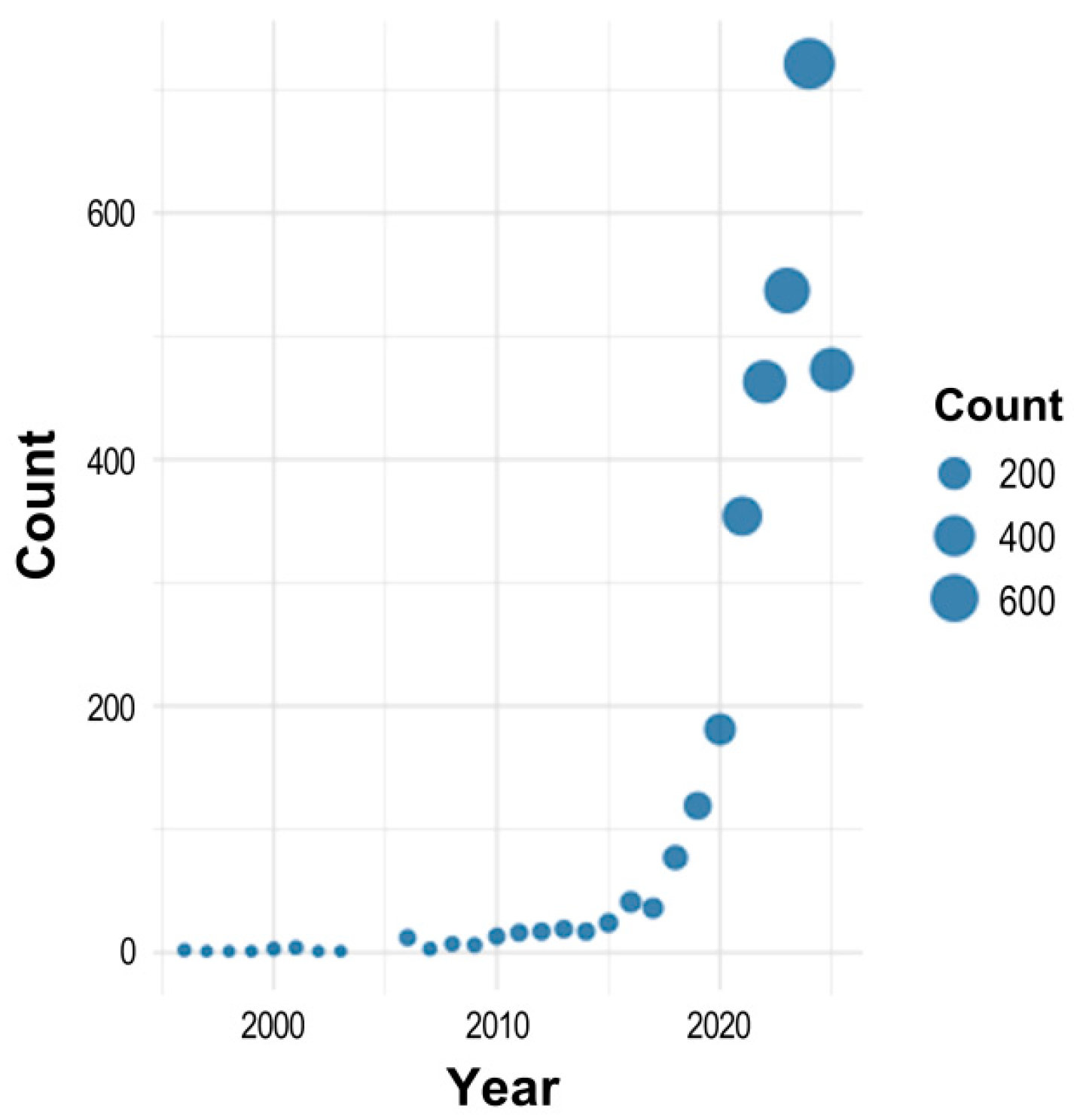
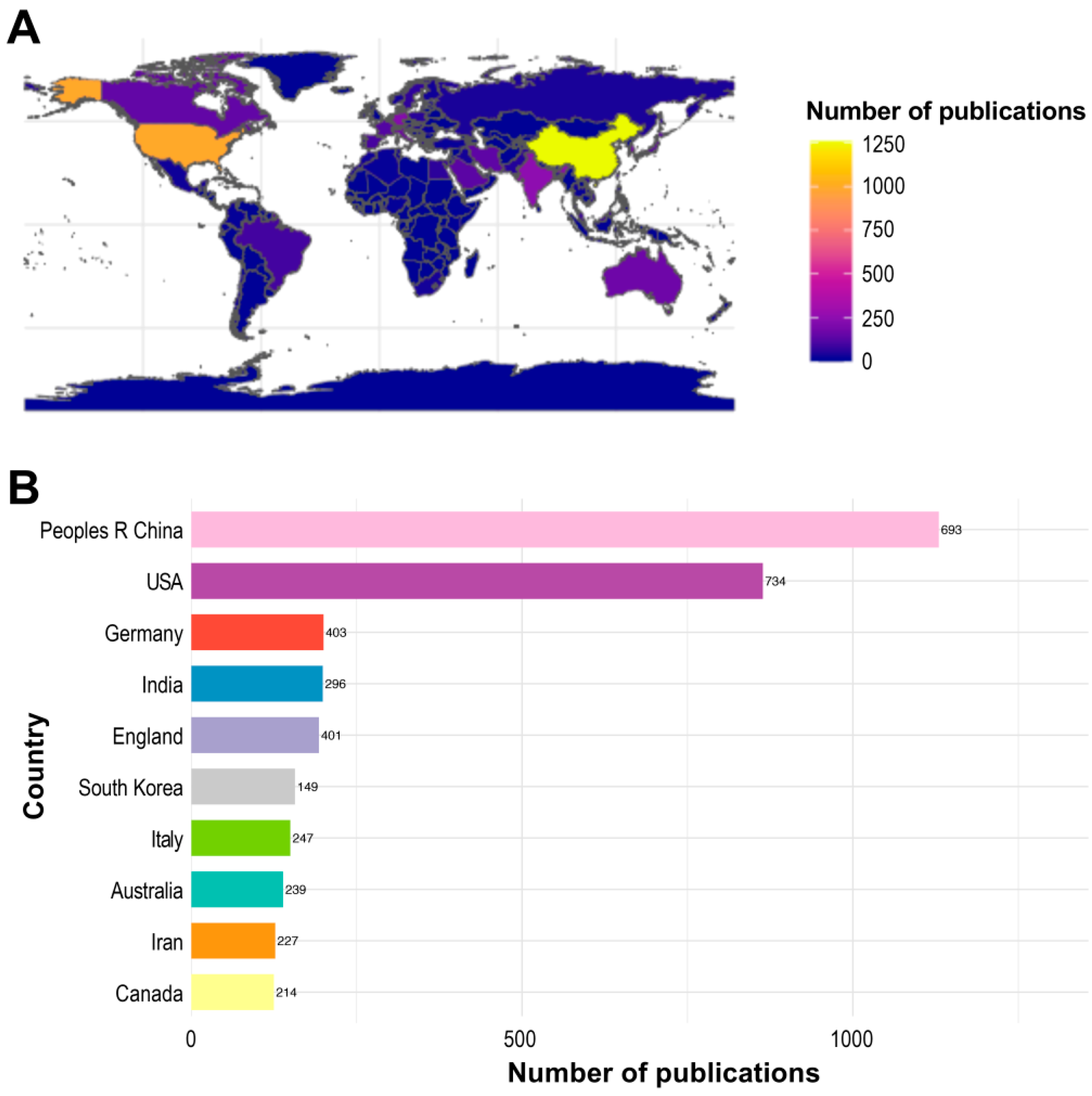
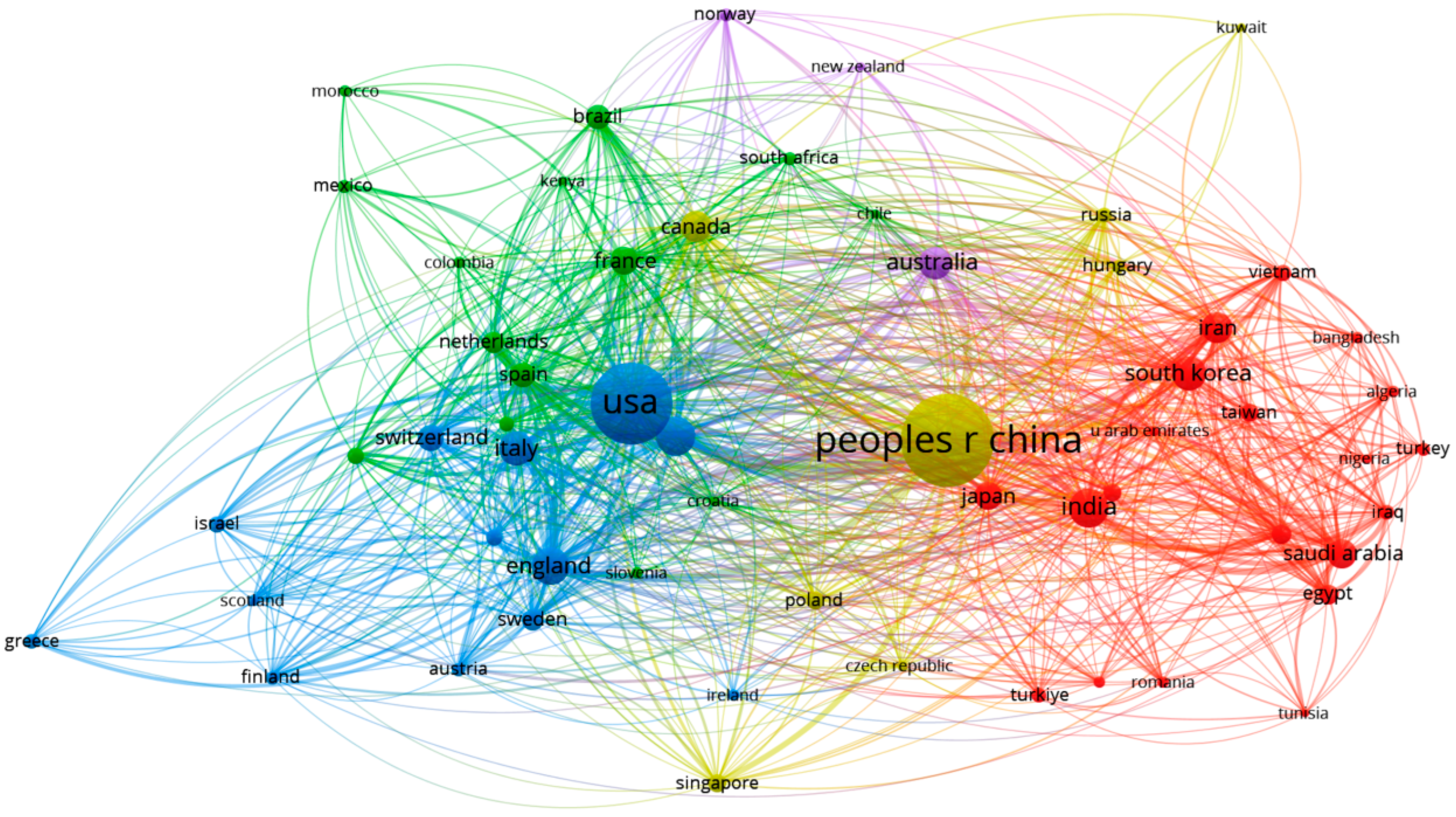
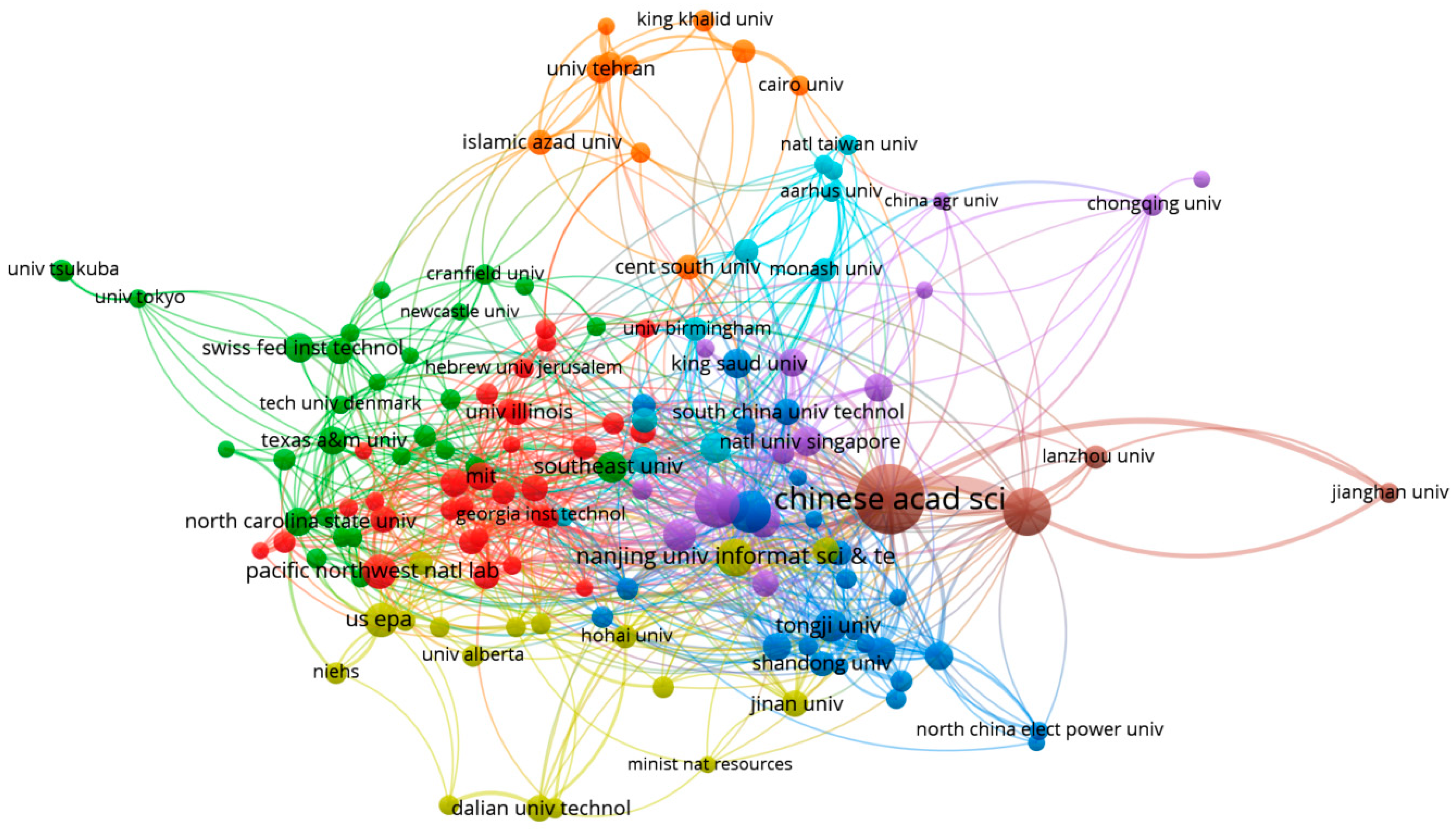


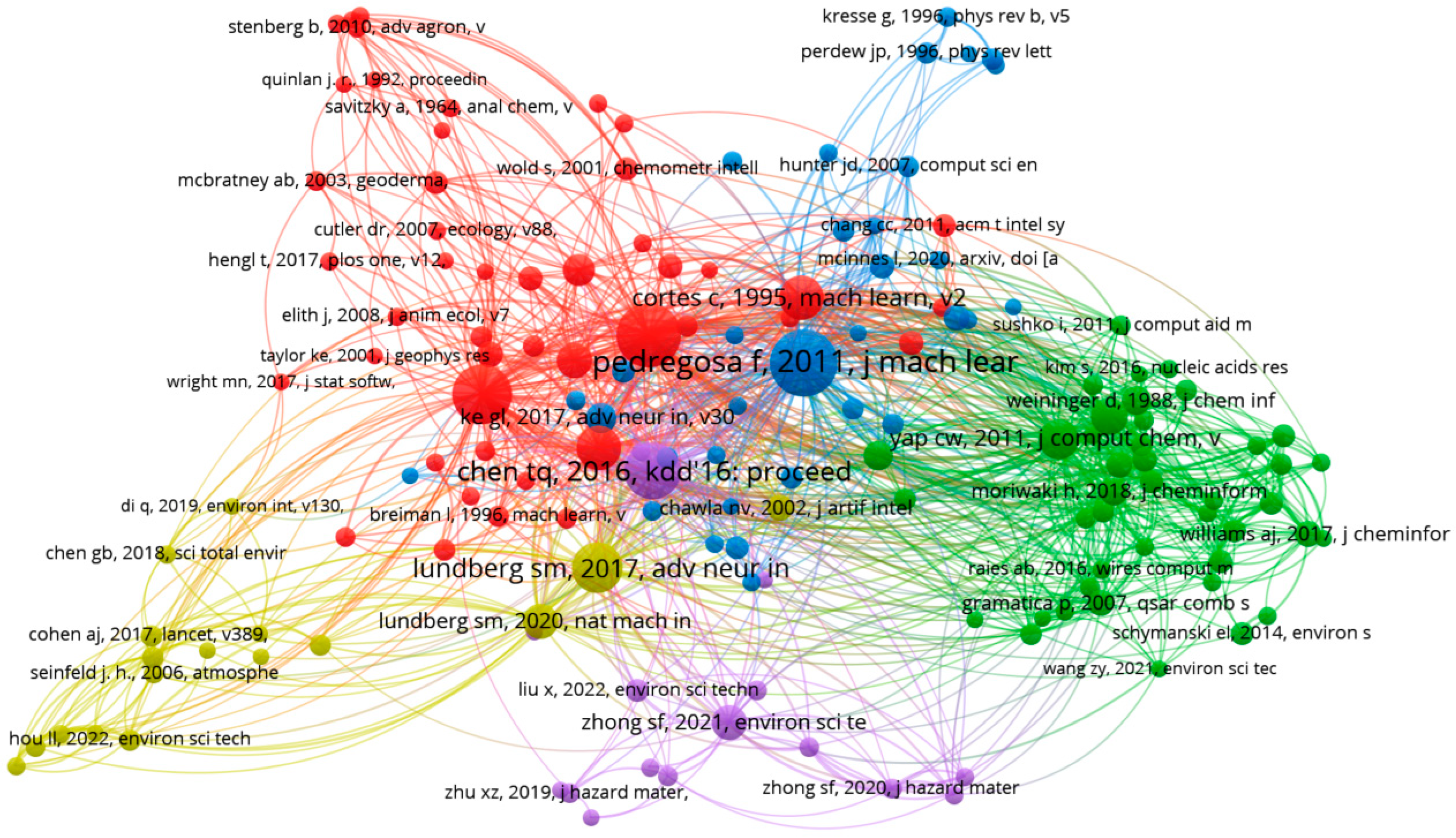
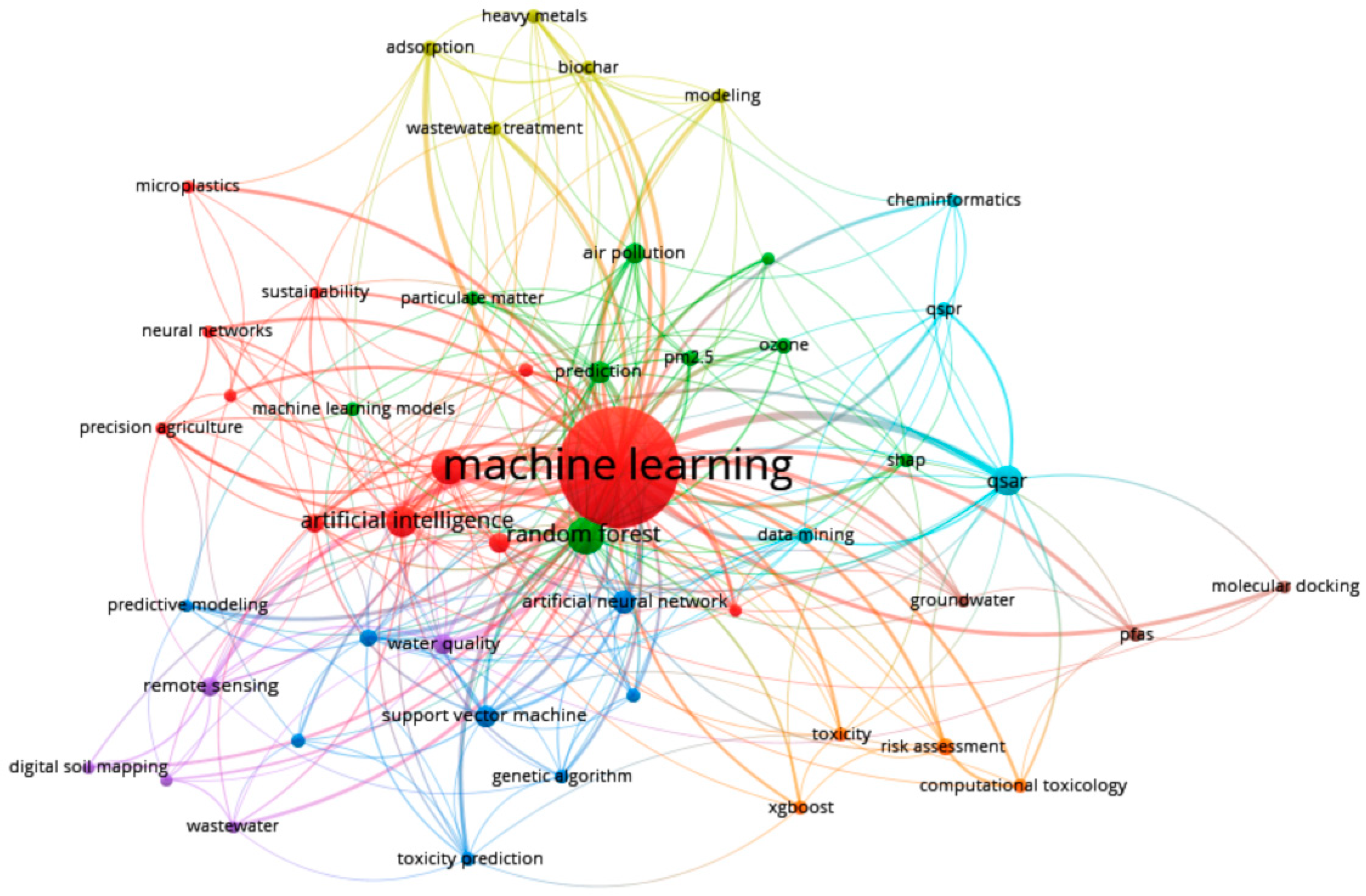
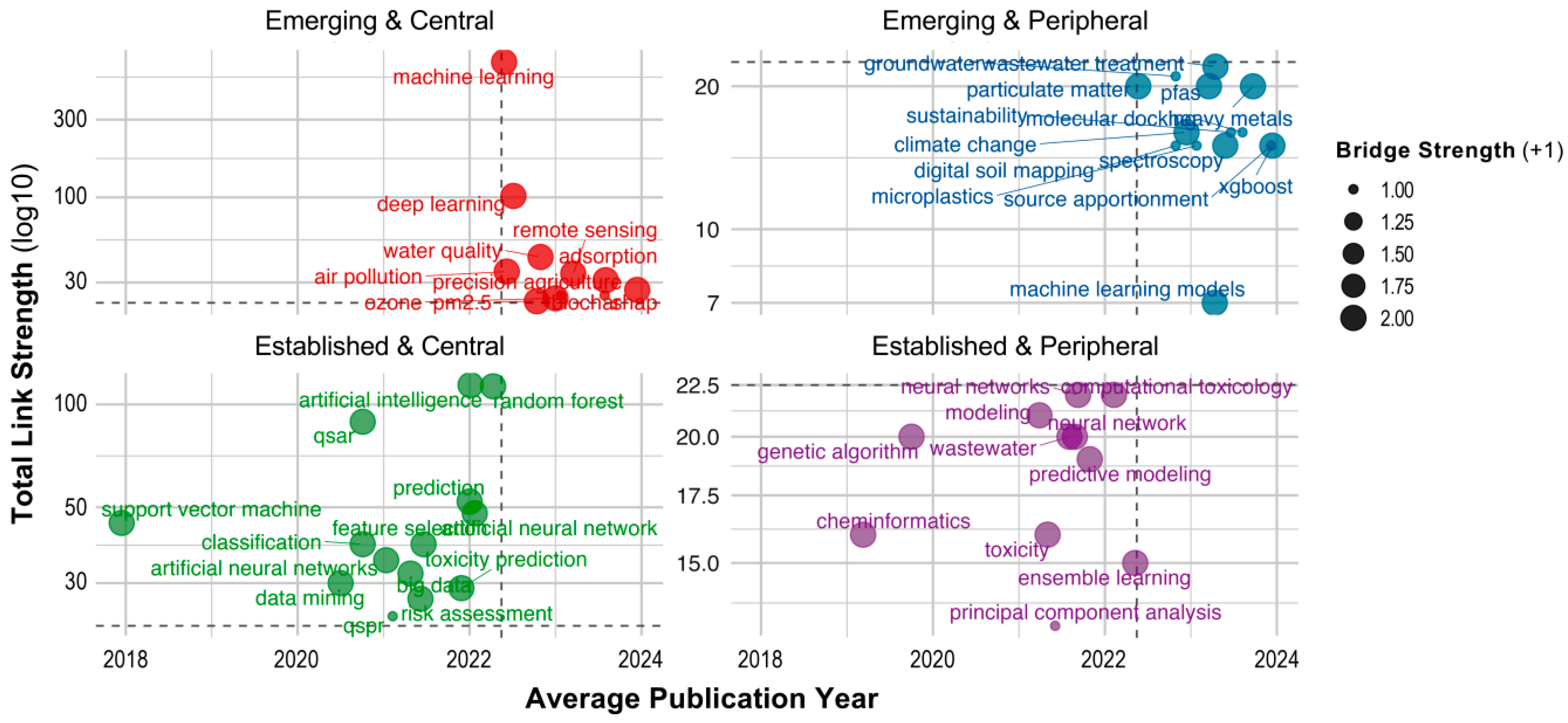

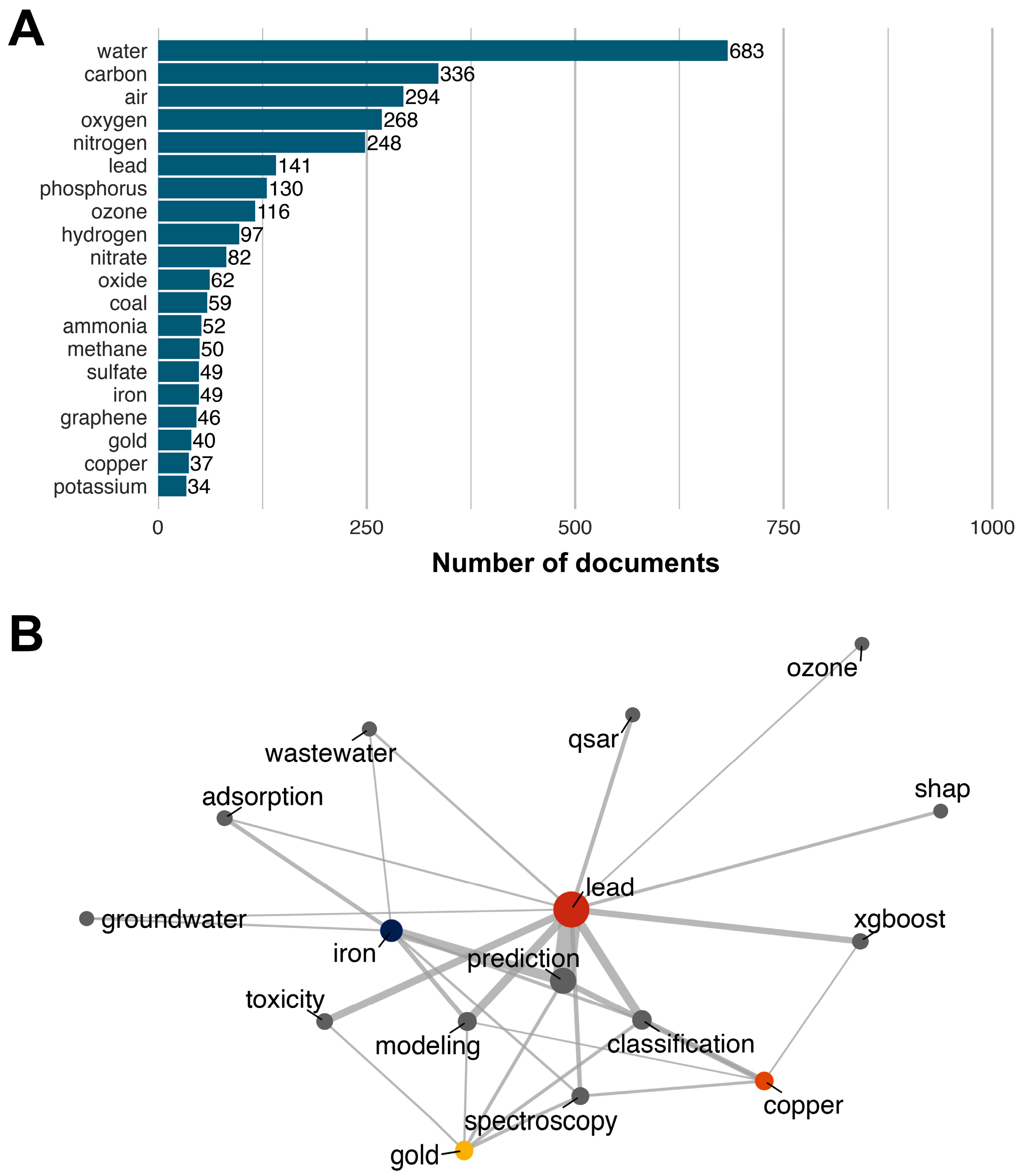

| Institution | Number of Publications | % of Total Output |
|---|---|---|
| Chinese Academy of Sciences | 174 | 5.55 |
| United States Department of Energy | 113 | 3.62 |
| University of California System | 106 | 3.39 |
| University of Chinese Academy of Sciences | 75 | 2.41 |
| Swiss Federal Institutes of Technology Domain | 64 | 2.03 |
| Tsinghua University | 64 | 2.03 |
| Centre National De La Recherche Scientifique | 57 | 1.81 |
| Zhejiang University | 55 | 1.75 |
| Helmholtz Association | 50 | 1.58 |
| Egyptian Knowledge Bank | 49 | 1.56 |
| Author Name | Affiliation | Number of Publications | Citations | TLS |
|---|---|---|---|---|
| Jingwen Chen | Dalian University of Technology, Dalian, China | 15 | 215 | 1923 |
| Hao Zhu | Tulane University, New Orleans, United States | 13 | 512 | 3441 |
| Weihua Li | East China University of Science and Technology, Shanghai, China | 13 | 512 | 3441 |
| Guixia Liu | East China University of Science and Technology, Shanghai, China | 13 | 512 | 3441 |
| Yun Tang | East China University of Science and Technology, Shanghai, China | 13 | 676 | 1156 |
| Yang Liu | Emory University, Atlanta, United States | 12 | 184 | 221 |
| Yinchang Feng | Nankai University, Tianjin, China | 11 | 263 | 368 |
| Huichun Zhang | Case Western Reserve University, Cleveland, United States | 10 | 277 | 1531 |
| Huixiao Hong | US Food and Drug Administration, Jefferson, United States | 10 | 771 | 499 |
| Tengyi Zhu | Yangzhou University, Yangzhou, China | 10 | 52 | 379 |
| Journal | Country | Cluster | Links | TLS | Citations | Impact Factor | Category Quartile |
|---|---|---|---|---|---|---|---|
| Environmental Science and Technology | USA | 3 | 275 | 190,071 | 4665 | 11.3 | Q1 |
| Science of the Total Environment a | Netherlands | 5 | 275 | 177,342 | 3959 | 8.0 | Q1 |
| Atmospheric Chemistry and Physics | Germany | 5 | 229 | 93,894 | 2156 | 5.1 | Q1 |
| Chemosphere b | Netherlands | 3 | 275 | 92,746 | 1931 | 8.1 c | Q1 |
| Atmospheric Environment | UK | 5 | 264 | 72,877 | 1701 | 3.7 | Q1 |
| Environmental Pollution | Netherlands | 5 | 272 | 71,492 | 1514 | 7.3 | Q1 |
| Water Research | Netherlands | 1 | 273 | 70,609 | 1795 | 12.4 | Q1 |
| Journal of Hazardous Materials | Netherlands | 4 | 275 | 67,983 | 1405 | 11.3 | Q1 |
| Chemical Engineering Journal | Switzerland | 4 | 273 | 67,687 | 1245 | 13.2 | Q1 |
| Journal of Cleaner Production | Netherlands | 4 | 273 | 60,527 | 1233 | 10.0 | Q1 |
| Name | Cluster | Links | TLS | Citations |
|---|---|---|---|---|
| Pedregosa, F., Varoquaux, G., Gramfort, A., Michel, V., Thirion, B. et al. 2011. Scikit-learn: Machine Learning in Python. Journal of Machine Learning Research 12(85), 2825–2830. | 3 | 141 | 935 | 303 |
| Breiman, L. 2001. Random Forests. Machine Learning 45, 5–32. | 1 | 142 | 868 | 279 |
| Lundberg, S.M., Lee, S.-I. 2017. A Unified Approach to Interpreting Model Predictions. Advances in Neural Information Processing Systems 30, arXiv:1705.07874. | 4 | 129 | 593 | 168 |
| Friedman, J.H. 2001. Greedy Function Approximation: A Gradient Boosting Machine. Annals of Statistics 29(5), 1189–1232. | 1 | 138 | 571 | 129 |
| Cortes, C., Vapnik, V. 1995. Support-Vector Networks. Machine Learning 20, 273–297. | 1 | 117 | 512 | 133 |
| Yap, C.W. 2011. PaDEL-descriptor: An open source software to calculate molecular descriptors and fingerprints. Journal of Computational Chemistry 32(7), 1466–1474. | 2 | 103 | 482 | 108 |
| Rogers, D., Hahn, M. 2010. Extended-Connectivity Fingerprints. Journal of Chemical Information and Modeling 50(5), 742–754. | 2 | 103 | 461 | 93 |
| Lundberg, S.M., Erion, G., Chen, H., DeGrave, A., Prutkin, J.M. et al. 2020. From Local Explanations to Global Understanding with Explainable AI for Trees. Nature Machine Intelligence 2(1), 56–67. | 4 | 98 | 356 | 86 |
| Zhong, S., Zhang, K., Bagheri, M., Burken, J.G., Gu, A. et al. 2021. Machine Learning: New Ideas and Tools in Environmental Science and Engineering. Environmental Science and Technology 55(19), 12741–12754. | 5 | 85 | 286 | 81 |
| Moriwaki, H., Tian, Y.-S., Kawashita, N., Takagi, T. 2018. Mordred: a molecular descriptor calculator. Journal of Cheminformatics 10, 4. | 2 | 89 | 277 | 54 |
| Cluster | Keywords | Count | Leading Keyword (TF-IDF) |
|---|---|---|---|
| 1 | Artificial Intelligence; Artificial Neural Networks; Big Data; Classification; Climate Change; Deep Learning; Machine Learning; Microplastics; Neural Networks; Precision Agriculture; Spectroscopy; Sustainability | 12 | Machine Learning |
| 2 | Air Pollution; Machine Learning Models; Ozone; Particulate Matter; PM2.5; Prediction; Random Forest; SHAP; Source Apportionment | 9 | Random Forest |
| 3 | Artificial Neural Network; Feature Selection; Genetic Algorithm; Neural Network; Predictive Modeling; Principal Component Analysis; Support Vector Machine; Toxicity Prediction | 8 | Artificial Neural Network |
| 4 | Adsorption; Biochar; Heavy Metals; Modeling; Wastewater Treatment | 5 | Adsorption |
| 5 | Digital Soil Mapping; Ensemble Learning; Remote Sensing; Wastewater; Water Quality | 5 | Water Quality |
| 6 | Cheminformatics; Data Mining; QSAR; QSPR | 4 | QSAR |
| 7 | Computational Toxicology; Risk Assessment; Toxicity; XGBoost | 4 | Risk Assessment |
| 8 | Groundwater; Molecular Docking; PFAS | 3 | PFAS |
Disclaimer/Publisher’s Note: The statements, opinions and data contained in all publications are solely those of the individual author(s) and contributor(s) and not of MDPI and/or the editor(s). MDPI and/or the editor(s) disclaim responsibility for any injury to people or property resulting from any ideas, methods, instructions or products referred to in the content. |
© 2025 by the authors. Licensee MDPI, Basel, Switzerland. This article is an open access article distributed under the terms and conditions of the Creative Commons Attribution (CC BY) license (https://creativecommons.org/licenses/by/4.0/).
Share and Cite
Stanic, B.; Andric, N. Mapping the Rise in Machine Learning in Environmental Chemical Research: A Bibliometric Analysis. Toxics 2025, 13, 817. https://doi.org/10.3390/toxics13100817
Stanic B, Andric N. Mapping the Rise in Machine Learning in Environmental Chemical Research: A Bibliometric Analysis. Toxics. 2025; 13(10):817. https://doi.org/10.3390/toxics13100817
Chicago/Turabian StyleStanic, Bojana, and Nebojsa Andric. 2025. "Mapping the Rise in Machine Learning in Environmental Chemical Research: A Bibliometric Analysis" Toxics 13, no. 10: 817. https://doi.org/10.3390/toxics13100817
APA StyleStanic, B., & Andric, N. (2025). Mapping the Rise in Machine Learning in Environmental Chemical Research: A Bibliometric Analysis. Toxics, 13(10), 817. https://doi.org/10.3390/toxics13100817





